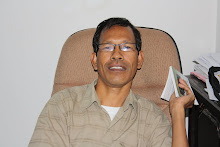By Konradus Epa, Jakarta
The Third Grand Synod of the Indonesian Catholic Church, scheduled for Nov. 1-5 in Bogor, West Java, will use a narrative or story-telling approach previously used by the Asian Mission Congress in 2006, says one of its chief organizers.
Divine Word Father Alfons Agustinus Duka, who heads the grand synod’s organizing committee, said the Telling the Story of Jesus in Asia theme at the Asian Mission Congress in Chiang Mai, Thailand, was an inspiration for the grand synod.
“The narrative approach can reveal faith,” he said.
Father Duka spoke to ucanews.com about the preparations and aims of the upcoming grand synod.
Q. How are preparations for the grand synod going?
A. We have prepared reflections and prayers related to the theme. Copies were distributed to each diocese. They are written in plain language so they will be easier for participants to digest.
We have also sent guidelines that will help participants present their life witnesses in a free and creative manner, based on three sub-themes: cultural diversity, interfaith dialogue, and marginalized people.
We chose this theme because we want to see more faith-based sharing, instead of theoretical discussions which occurred in the two previous grand synods. It’s also an invitation for Catholics to be aware of their calling and to proclaim the good news in their daily lives.
Jesus’ life will be the main focus of the grand synod.
Q. How will this be done?
A. Pope John Paul II, in his encyclical Ecclesia in Asia, affirmed that the Church’s mission is to have faith sharing in light of faith in Jesus Christ. It is a gift that we must accept and share with others. This faith sharing should be done by using a narrative approach.
We will use a narrative approach because it can reveal faith. Each participant representing every diocese will be given an opportunity to tell a story, and this story must reflect the Gospel and Church’s teachings. By doing this, we will get clues which can be used to identify the depth of our faith experience.
Q. Why a narrative approach?
A. By telling a story, a person can reveal their identity: who he/she is, where he/she is from, and whom he/she is related to. Telling a story relates with others and is something which can be seen, touched and felt.
By telling a story, someone can also relate how he/she experiences things. It includes their faith experience in Jesus, which may be difficult to understand if it is defined in a scientific way.
Jesus himself always used stories. When answering the question “who is my neighbor?” Jesus did not define it. Instead, he told a story, of which we finally called the neighbor a Good Samaritan.
In his encyclical Ecclesia in Asia, Pope John Paul II says story telling is a pedagogy which suits nations best.
Q. What will the content of the stories be?
A. Participants’ faith experience should be based on the context of Indonesia, which is diverse and complex. Amongst this diversity and complexity, however, the bishops have chosen to focus on three main issues: Socio-cultural life, religious life, and socio-economic life, which are the grand synod’s sub-themes.
The introduction of Jesus’ face will also be presented throughout the whole program of the grand synod, such as in the inculturated Eucharist services and cultural performances.
Q. Can you outline the topics for discussion?
A. We will discuss three subjects: Recognizing Jesus’ face in cultural diversity, recognizing Jesus’ face in interfaith dialogue, and recognizing Jesus’ face in the life of marginalized people.
With interfaith dialogue, we will invite other religious followers –- Buddhists, Muslims and followers of traditional beliefs –- to share with us about their faith experiences.
Q. What makes this year’s grand synod unique?
A. The two previous grand synods focused on scientific and intellectual analysis. This year will be a faith celebration and sharing in light of the Gospel.
This year’s synod is organized as follow-up to the Asian Mission Congress in 2006.
Q. How many Catholics will take part?
A. About 500 participants. Each diocese will send a delegation of 6-10 people including the bishop, priests, nuns, brothers and laypeople.
We hope participants come from various institutions and organizations, or those who take an active part in interfaith dialogues, activities related to their cultures and services to the poor.
Q. What do you expect from participants after the synod?
A. We hope they will put into practice the grand synod’s recommendations after they go back to their own dioceses, parishes and ecclesial communities.
http://www.ucanews.com/
27 Agustus 2010
Langganan:
Posting Komentar (Atom)














Tidak ada komentar:
Posting Komentar